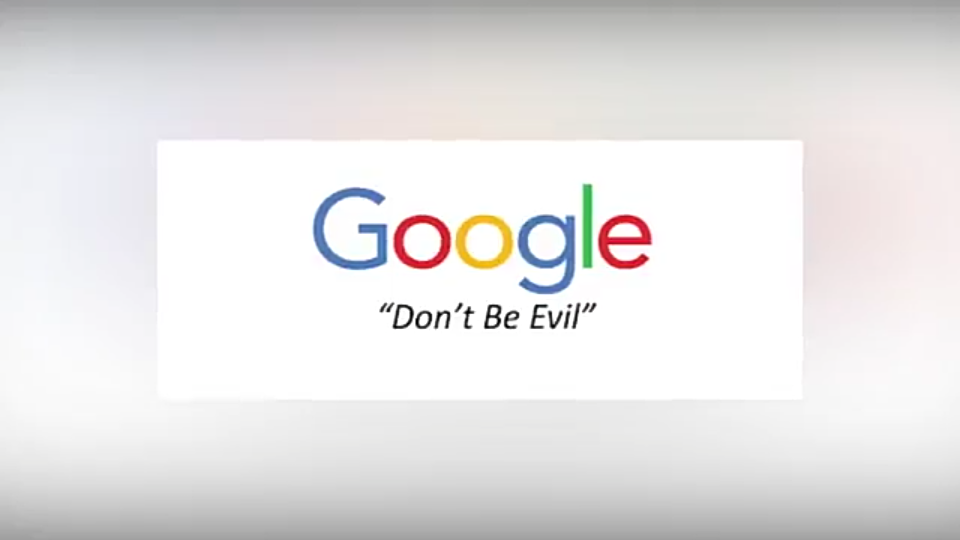5 secret facts about google that you don’t know!

History of Google
The Google company was officially launched in 1998 by Larry Page and Sergey Brin to market Google Search, which has become the most used web-based search engine. Larry Page and Sergey Brin, students
at Stanford University in California, developed a search algorithm at first known as “BackRub” in 1996, with the help of Scott Hassan and Alan Steremberg. The search engine soon proved successful and the expanding company moved several times, finally settling at Mountain View in 2003. This marked a phase of rapid growth, with the company making its initial public offering in 2004 and quickly becoming one of the world’s largest media companies. The company launched Google News in 2002, Gmail in
2004, Google Maps in 2005, Google Chrome in 2008, and the social network known as Google+ in 2011 (which was shut down in April 2019), in addition to many other products. In 2015, Google became the main subsidiary of the holding company Alphabet Inc. The search engine went through a lot of updates in attempts to combat search engine optimization abuse, provide dynamic updating of results, and make the indexing system rapid and flexible. Search results started to be personalized in 2005, and later Google Suggest autocompletion was introduced. From 2007, Universal Search provided all types of content, not just text content, in search results. Google has engaged in partnerships with NASA, AOL, Sun Microsystems, News Corporation, Sky UK, and others. The company set up a charitable offshoot, Google.org, in 2005. Google was involved in a 2019 legal dispute in the US over a court order to disclose URLs and search strings, and has been the subject of tax avoidance investigations in the UK. The name Google is a misspelling of Googol, the number 1 followed by 100 zeros, which was picked to signify that the search engine was intended to provide large quantities of information.
BEGINNING
Google has its origins in “BackRub”, a research project that was
begun in 1996 by Larry Page and Sergey Brin when they were both
PhD students at Stanford University in Stanford, California.[2] The project
initially involved an unofficial “third founder”, Scott Hassan, the lead
programmer who wrote much of the code for the original Google Search
engine, but he left before Google was officially founded as a company;[3][4]
Hassan went on to pursue a career in robotics and founded the company
Willow Garage in 2006.[5][6]
In the search of a dissertation theme, Page had been considering among
other things exploring the mathematical properties of the World Wide Web,
understanding its link structure as a huge graph.[7] His supervisor, Terry
Winograd, encouraged him to pick this idea (which Page later recalled as
“the best advice I ever got”[8]) and Page focused on the problem of finding
out which web pages link to a given page, based on the consideration that
the number and nature of such backlinks was valuable information about
that page (with the role of citations in academic publishing in mind).[7]
Page told his ideas to Hassan, who began writing the code to implement
Page’s ideas.[3] The research project was nicknamed “BackRub”, and it was soon joined by Brin, who was supported by a National Science Foundation Graduate Fellowship.[9] The two had first met in the summer of 1995, when Page was part of a group of potential new students that Brin had volunteered to give a tour around the campus and nearby San Francisco.[7] Both Brin and Page were working on the Stanford Digital Library Project (SDLP). The SDLP’s goal was “to develop the enabling technologies for a single, integrated and universal digital library” and it was funded through the National Science Foundation, among other federal agencies.[9][10][11][12] Page’s web crawler began exploring the web in March 1996, with Page’s own Stanford home page serving as the only starting point.[7] To convert the backlink data that it gathered for a given web page into a
measure of importance, Brin and Page developed the PageRank algorithm.[7] While analyzing BackRub’s output which, for a given URL, consisted of a list of backlinks ranked by importance the pair realized that a search engine based on PageRank would produce better results than existing techniques (existing search engines at the time essentially ranked results according to how many times the search term appeared on a page).[7][13]
Convinced that the pages with the most links to them from other highly relevant Web pages must be the most relevant pages associated with the search, Page and Brin tested their thesis as part of their studies,
and laid the foundation for their search engine.[14] The first version of Google was released in August 1996 on the Stanford website. It used nearly half of Stanford’s entire network bandwidth.
late 1990s
Originally the search engine used Stanford’s website with the domains google.stanford.edu[21] and z.stanford.edu.[22] The domain google.com was registered on September 15, 1997. They formally incorporated their company, Google, on September 4, 1998 in their friend Susan Wojcicki’s garage in Menlo Park, California. Wojcicki eventually became an executive at Google and is now the CEO at YouTube. Both Brin and Page had been against using advertising pop-ups in a search engine, or an “advertising
funded search engines” model, and they wrote a research paper in 1998 on the topic while still students. They changed their minds early on and allowed simple text ads.[23] By the end of 1998, Google had an index of about 60 million pages.[24] The home page was still marked
“BETA”, but an article in Salon.com already argued that Google’s search results were better than those of competitors like Hotbot or Excite.com, and praised it for being more technologically innovative than the
overloaded portal sites (like Yahoo!, Excite.com, Lycos, Netscape’s Netcenter, AOL.com, Go.com and (MSN.com) which at that time, during the growing dot-com bubble, were seen as “the future of the Web”,
especially by stock market investors.[24] Early in 1999, Brin and Page decided they wanted to sell Google to Excite. They went to Excite CEO
George Bell and offered to sell it to him for $1 million. He rejected the offer. Vinod Khosla, one of Excite’s venture capitalists, talked the duo down to $750,000, but Bell still rejected it.[25] In March 1999, the company moved into offices at 165 University Avenue in Palo Alto, home to several
other noted Silicon Valley technology startups.[26] After quickly outgrowing two other sites, the company leased a complex of buildings in Mountain View at 1600 Amphitheatre Parkway from Silicon Graphics
(SGI) in 2003.[27] The company has remained at this location ever since, and the complex has since become known as the Googleplex (a play on the word googolplex, a number that is equal to 1 followed by (a googol of zeros). In 2006, Google bought the property from SGI for US$319 million.[28]
2000s
The Google search engine attracted a loyal following among the
growing number of Internet users, who liked its simple design.[29] In
2000, Google began selling advertisements associated with search
keywords.[2] The ads were text-based to maintain an uncluttered
page design and to maximize page loading speed.[2] Keywords were
sold based on a combination of price bid and click-throughs, with
bidding starting at $.05 per click.[2] This model of selling keyword
advertising was first pioneered by Goto.com, an Idealab spin-off
created by Bill Gross.[30][31] When the company changed names to
Overture Services, it sued Google over alleged infringements of the
company’s pay-per-click and bidding patents. Overture Services
would later be bought by Yahoo! and renamed Yahoo! Search
Marketing. The case was then settled out of court; Google agreed to
issue shares of common stock to Yahoo! in exchange for a perpetual
license.[32][33][34][35] While many of its dot-com rivals failed in the
new Internet marketplace, Google quietly rose in stature while
generating revenue.[2]
Google’s declared code of conduct is “Don’t be evil”, a phrase which
they went so far as to include in their prospectus (aka “S-1”) for their
2004 IPO, noting that “We believe strongly that in the long term, we
will be better served—as shareholders and in all other ways—by a
company that does good things for the world even if we forgo some
short term gains.”[36]
In February 2003, Google acquired Pyra Labs, owner of the Blogger
website. The acquisition secured the company’s competitive ability to use information gleaned from blog
postings to improve the speed and relevance of articles contained in a companion product to the search
engine Google News.
In February 2004, Yahoo! dropped its partnership with Google, providing an independent search engine of its own. This cost Google some market share, yet Yahoo!’s move highlighted Google’s own distinctiveness, and today the verb “to google” has entered a number of languages (first as a slang verb
and now as a standard word), meaning “to perform a web search” (a possible indication of “Google” becoming a genericized trademark).
After the IPO, Google’s stock market capitalization rose greatly and
the stock price more than quadrupled. On August 19, 2004, the
number of shares outstanding was 172.85 million while the “free
float” was 19.60 million (which makes 89% held by insiders). Google
has a dual class stock structure in which each Class B share gets ten
votes compared to each Class A share getting one. Page said in the
prospectus that Google has “a dual class structure that is biased
toward stability and independence and that requires investors to bet
on the team, especially Sergey and me.”
In June, 2005, Google was valued at nearly $52 billion, making it
one of the world’s biggest media companies by stock market value.[37]
On August 18, 2005 (one year after the initial IPO), Google announced that it would sell 14,159,265
(another mathematical reference as π ≈ 3.14159265) more shares of its stock to raise money. The move
would double Google’s cash stockpile to $7 billion. Google said it would use the money for “acquisitions of complementary businesses, technologies or other assets”.[38] With Google’s increased size came more competition from large mainstream technology companies. One such example is the rivalry between Microsoft and Google.[39] Microsoft had been touting its Bing search engine to counter Google’s competitive position. Furthermore, the two companies are increasingly offering overlapping services, such as webmail (Gmail vs. Hotmail), search (both online and local desktop searching), and other applications (for example, Microsoft’s Windows Live Local competes with (Google Earth). In addition to an Internet Explorer replacement Google designed its own Linux-based operating system called Chrome OS to directly compete with Microsoft Windows. There were also
rumors of a Google web browser, fueled much by the fact that Google was the owner of the domain name “gbrowser.com”. These were later proven when Google released Google Chrome. This corporate feud
boiled over into the courts when Kai-Fu Lee, a former vice-president of Microsoft, quit Microsoft to work for Google. Microsoft sued to stop his move by citing Lee’s non-compete contract (he had access to much
sensitive information regarding Microsoft’s plans in China). Google and Microsoft reached a settlement out of court on December 22, 2005, the terms of which are confidential.[40]
Click fraud also became a growing problem for Google’s business strategy. Google’s CFO George Reyes said in a December 2004 investor conference that “something has to be done about this really, really quickly, because I think, potentially, it threatens our business model.”[41] While the company’s primary market is in the web content arena, Google has experimented with other markets, such as radio and print publications. On January 17, 2006, Google announced that it had purchased the radio advertising company dMarc, which provides an automated system that allows companies to advertise on the radio.[42] Google also began an experiment in selling advertisements from its advertisers in offline newspapers and magazines, with select advertisements in the Chicago SunTimes.[43] During the third quarter 2005 Google Conference Call, Eric Schmidt said, “We don’t do the same thing as everyone else does. And so if you try to predict our product strategy by simply saying well so and so
has this and Google will do the same thing, it’s almost always the wrong answer. We look at markets as they exist and we assume they are pretty well served by their existing players. We try to see new
problems and new markets using the technology that others use and we build.” After months of speculation, Google was added to the Standard & Poor’s 500 index (S&P 500) on March 31, 2006.[44] Google replaced Burlington Resources, a major oil producer based in Houston that had
been acquired by ConocoPhillips.[45] The day after the announcement Google’s share price rose by 7%.[46]
In 2008, Google launched Knol, their own equivalent of Wikipedia,[47] which failed four years later.[48]
Google LLC is an american multinationsal technology that specializes in internet related services and products, which include online advertising technologies, search engine, cloud computing, software, and hardware.
CEO of Google: Sundar Pichai
Subsidiaries: Youtube, Google.org, Google Nest, Youtube TV, Google AdMob, Kaggle and more…
Founders: Larry page, Sergey brin
By not getting late let’s go to our topic “5 intresting facts of google which you are unknown about it”.
FACT NO. 1:
Before 1997 the name of google was BLACKRUF but due to the intrest of the founders of google(Larry page, Sergey brin) in mathematics later its name was changed to GOOGOL. In mathematics GOOGOL means that the number having hundred 0 in front of 1 ater they went to the invester and the invester mistakely named it GOOGLE after that the name of this famous search engine was named GOOGLE.

FACT NO. 2:
Do you know? The unofficial sologan of google is “Don’t be evil”. It has a deep meaning. It means that google have a lot of data google is well known about the most of internet users. So if google started to use our information or idenity in the evil way then it can be horrible. so the unofficial sologan of Google is “Don’t be evil“

FACT NO. 3:
Do you know? Google gets how many searches in a day? and the fact is google gets more than 1 billions of search request in a day. It also means that google shows more than 1 billions of results in one search. For doing this google has built many servers in different places of the world.

FACT NO. 4:
This also the most intresting fact of google. Stay cliam for it this will be memorable fact for you about GOOGLE & the fact is the employees working in google are called Googlers but the new employees working in the google are called “Nooglers“.

FACT NO. 5:
After 2010 Google accuires one company weekly it means that google buys one company every week. This makes the google protfolios full of companies.

Thanks for visiting our page and reading the facts. I wish you have understood all the facts of google which are mentioned above.
Visit our youtube channel : https://www.youtube.com/c/techtipsbysamyog







